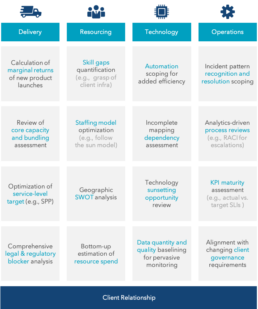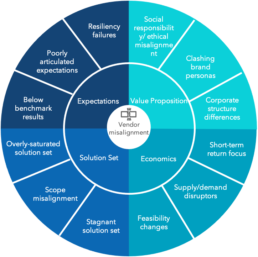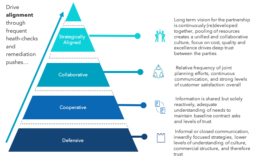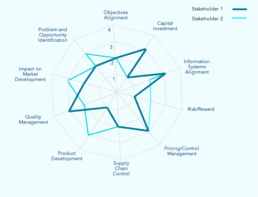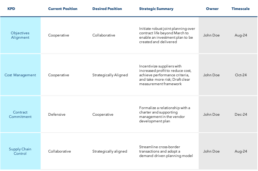Challenges of Modern Client Relationships
In 2016, American Express (Amex) made headlines: after a fourteen-year co-branded credit card partnership with Costco, the membership-based discount chain cut its ties.(1) This divorce resulted in a insurmountable customer retention deficit for Amex, which at the time had 1 in 10 of its cards in circulation under the Costco-Amex card arrangement(2). Though Amex was able to eventually rebound from this 3% revenue dip through a renewed focus on their platinum program, the incident served as a reminder to B2B enterprises everywhere: client relationships, no matter how large and long-standing, must remain aligned on value proposition, economics, interaction, and expectations, or they will collapse.
Increasing digital disruption is accelerating change and increasing competition. Proactively maintaining and growing client relationships is essential for continued contract renewals and preventing brand-damaging fallouts. As part of any client contract, there will be periods of re-negotiation when it comes to fees, services, and interaction models. It is therefore crucial for both parties to think beyond the mere prioritization of pricing terms and appreciate contracts for what they are: formalizations of a mutually beneficial relationship aimed at creating value for both sides. If firms can accept this premise, focusing on building trust and alignment through open cooperation, they will ultimately realize heightened financial results. An effective system of client relationship governance can be summarized into models for long- term strategic alliance and will be examined in depth within this white paper. Particularly during Covid-19, which has put a strain on many businesses and forced industries to pivot, the stakes have never been higher. Disruptive business context has led to greater urgency in how enterprises gain access to specific capabilities, whether by quickly adapting core services to meet changing customer needs, or migrating/augmenting face-to-face sellers to digital channels. Since the onset of the pandemic, there has been a 52% drop in traditional sales models, which have been replaced with purely virtual interactions and omnichannel sales(3). The rapid transformation of tools and processes has redefined the pace and nature of client interaction.
Simply put, now more than ever before, clients expect a lot: newer products, shorter times to market, more targeted services, greater exploitation of data and analytics, end-to-end solutions, and socially responsible business frameworks. However, managed service providers are struggling to rise to the challenge of those ever-increasing demands. According to a recent survey conducted by Alliance Best Practice, 40% of commercial alliances today fail to comprehensively address commercial, strategic, operational, cultural, and technological baselines. More significantly, ~70% of all corporate alliances end in divorce(4). Not only are enterprises struggling to meet customer expectations, but they are also not effectively mitigating problems and incorporating feedback appropriately.
Exhibit 1: Customer Relationship Assessment Framework
Data Driven Frameworks can guide fortification
Leveraging Kepler Cannon’s proven frameworks for diagnosing partner relationships, highlighting strengths and weaknesses, and predicting key areas of change is an important first step to fortifying your strategic customer relationships. This approach includes a comprehensive dashboard and solution-set to both mitigate current problems and prevent future misalignments from arising.
Kepler Cannon can effectively focus analytics tools and data deep dives to ascertain most at-risk performance areas, such as product scope and delivery models. Ultimately, by prioritizing quick wins and assessing the scope for improving product and delivery services across relevant geographies, firms can generate a strategic roadmap to also drive efficient client management.
In such he-said/she-said situations, an independent third-party can serve to provide impartial perspective and mitigate potential conflicts. Specifically, by removing politics from decision making, neither the client nor the service provider need speculate over the motives behind provided expertise. Such a set up allows both parties to pursue more collaborative and meaningful collaboration moving forward.
Why Client Relationships are failing
All happy client relationships are alike; however, every unhappy client relationship is unhappy in its own way. No two businesses offer the same set of services, nor foster the same management structure. Furthermore, there is rarely a single point of failure leading to the fallout of client contracts, but rather an amalgamation of unresolved inefficiencies and incidents that build up over time, leading to a point of no return.
Though service provider relationships may ultimately be cancelled due to singular events, such incidents are generally superficial indicators, and not the source of failure itself. This white paper will consequently focus on major sources of failure that can be prevented, thus minimizing contract-breaking incidents.
In our experience, most issues can be distilled into a problem of misalignment in four categories:
1.Value Proposition
2.Economics
3.Solution Set
Telltale signs of failure
Issue types can manifest in diverse ways but can all ultimately be traced back to misalignment
Exhibit 2: Types of service provider – client misalignment
What lies ahead?
1. Value Proposition
If firms fail to adequately align on their vision and reason for the partnership’s existence, beyond being a money making vehicle, the result is often that one or both parties will decide to leave.
These differences to some extent are inherent but can be detrimental if they are not targeted early. Value proposition mismatch can be generally defined as a failure to recognize a client’s fundamental mission and delivery model. This is often manifested through clashes in already-established brand between the two enterprises, or distinguished views on ethics and social responsibility.
From the start of the Costco-Amex partnership, there were latent concerns, as the two companies had entirely different brand profiles. Amex was recognized as a card for the distinguished spender, while Costco marketed itself as a discounter. Ultimately Costco wanted a card that could be used anywhere, and given Amex’s high fees that limited the card’s adoption rate, usability and public perception, Costco eventually opted for a Visa product instead.
Even something as seemingly insignificant as differences in corporate attitudes can fester, snowballing into a larger problem of tension and distrust. To prevent a dissolution of the partnership, it is necessary to be cognizant of brand differences when initially entering into an agreement, and to subsequently engage in targeted marketing campaigns and product development to align to the client’s vision and brand profiles.
2. Economics
Economic concerns can cause a partnership’s demise if mutually-equitable terms are not reached. Since initial pricing negotiation takes place before contracts are signed, partnership failures due to pricing result from lack of flexibility to adapt to macro circumstances, such as a change in supply or demand, or in today’s world, Covid-19. If service providers are rigid in their terms, solely prioritizing financial gain or maintaining status quo at the expense of partner loyalty, the relationship will suffer.
Aviva, a multinational insurance company withdrew from its partnership with DBS Bank in 2016 due to unresolved pricing disagreements: DBS wanted to increase fees during contract renewal, and Aviva refused, since DBS made up only 3% of their new business value.5 Despite the longstanding fourteen-year partnership, both parties refused to budge on pricing, and DBS ultimately chose to sign instead with Manulife, a competitor willing to pay the higher price in order to gain market share in Asia.
This example highlights the companies’ failure to negotiate and serves as an example of a zero-sum fallacy, incorrectly assuming one party will be forced to accept unfavorable financial terms. Aviva could have refined the solution scope of the contract to maintain the same price per service while reducing overall costs for their client. In many such instances, therefore, pricing failure is more of a failure to understand and anticipate clients’ needs and advocate for them appropriately.
3. Solution Set
The appropriate solution set is a delicate equilibrium — too saturated a solution set and a service provider’s ability to effectively allocate human capital, monetary, and technological resources gets diluted. However, without diversified offerings, a service provider will have all their eggs in one basket and face greater risk of being replaced.
In 2019, Cognizant announced its public split from Facebook, the company’s largest client. Though Cognizant offers a wide set of digital technology solutions globally, the partnership with Facebook was a single-service content moderation contract. The partnership ended due to complaints regarding unsafe content that employees were asked to moderate, but had the partnership with Facebook been a multi-solution one, Cognizant would have been able to refocus on the other services in its roster with Facebook. Without a diversified solution contract, Cognizant was forced to pull out of the partnership entirely.
Subsequently, Cognizant lost $300 million in revenue from its largest customer, was forced to cut 6,000 jobs, and ultimately made the decision to exit the content moderation space altogether(6). This fallout is an important lesson of what could have been avoided had the service agreement between Facebook and Cognizant been more diversified.
4. Expectations
Failure to meet expectations can manifest in many ways, be that data inaccuracies, lack of enterprise resiliency, or subpar sales performance. Generally, though, expectation misalignment is the result of poor managerial oversight, leading to a lack of clearly defined roles, and in turn, operational inefficiency.
In 2017, IBM signed a servicing contract with AECOM, a leading infrastructure engineering firm, in which they agreed to assist in designing process controls and generating automatic workflow software. According to several inside reports, IBM’s IT solutions had not worked as intended, seriously straining the partnership. Discussions of early contract termination ensued. This public scrutiny of IBM, in turn, called into question the company’s system of management and stewardship
Failure to reach baseline performance expectations not only affects the service in question, but also has the potential to spill into other relationships and tarnish futures sales efforts. Enterprises are attuned to the performance of their competitors and can access this type of information readily in today’s digital world. Therefore, the performance of a service provider are both a symptom and a cause of a company’s ability to foster long term growth.
What does 'good' look like?
Successful customer and service provider relationships are those that preserve trust. 65% of failed client relationships occur due to a lack of trust in the service provider(7). Just as is the case with interpersonal relationships, trust is built through understanding customer’s needs, ensuring strategic alignment, and pushing relationships away from defensive interactions focused exclusively on financial gain. In considering financial efficacy, it is important to not lose sight of the lifetime customer value, rather than trying to maximize profit at every step. If service providers prioritize personal needs and immediate returns, nearly every partnership will end in a divorce. These fallouts will just as often lead to higher net costs when factoring in the cost of new customer acquisition, not to mention the cost of negative press.
Despite instances of failure, demand for partnerships is strong. Across industries, CEOs rated partnerships as key to business operations in 72% of cases.8 It is therefore critical for vendors to capitalize on the most insightful resources at their disposal:
1. Establish Executive Accountability
Sufficient governance sits at the core of a mutually entrusted partnership. This entails having accountability for success of your prized client relationships with a senior executive to curate a centralized system for tracking communication and major decisions, flagging concerns when they arise, and promoting frequent client feedback. By having this strong relationship bridge, the service provider can be proactive instead of reactive, anticipating client’s needs and gaining their trust in return.
2. Leverage Bespoke KPIs
‘Expressive’ KPIs tailored to the client are imperative for measuring managerial effectiveness, looking specifically at consistency and timeliness of delivery, technological effectiveness, customer satisfaction, and general performance. Relying on standard SLAs and KPI reports does not allow for predictive analysis or realization of unforeseen issues. KPIs must also include a pre-set quantitative target for unbiased assessment of whether outcomes are satisfactory.
Exhibit 3: Hierarchy of client-service provider trust
Periodic health checks mitigate long term costs
It is crucial to have health checks periodically to look for weak spots and push for remediation. Routine checkups extend the life of the partnership and reduce both long-term costs and emotional strife by catching defects before they escalate into potentially unresolvable problems that erode trust in the partnership. The remediation efforts that come out of these health checks can be thought of as partnership touch-ups and are essential to fortifying relationships in the long-run.
These health-checks, though drafted by the service provider, should be completed by various stakeholders within the customer enterprise to ensure all concerns are voiced. They can be structured in any number of ways but should at minimum include:
1. Scoring models for relationship KPDs
Service Providers need a scaled scoring model to rate each key performance driver (KPD) within the partnership ranging from defensive, cooperative, collaborative, to strategically aligned. Examples of KPDs will vary depending on the industry and vertical, as well as the scope of the relationship, but typical examples include strategic alignment and continuous innovation.
2. Indicators
In order to rank KPDs, vendors need to leverage pointed indicators that are both mutually exclusive (pertaining only to the KPD in question) and collectively exhaustive (guaranteeing all considerations pertaining to the vendor’s performance will be acknowledged). These indicators will likely closely resemble other KPIs used by the vendor but be measured differently.
Each indicator should be mapped to gain a relative sense of the strong and weak indicators, the strength of the KPD overall, and how various stakeholders’ feedback compare, with particular attention to outliers.
Exhibit 4: Health-check scorecard
3. Step-by-step action plan
After successfully completing the health check, enterprises can move into drafting a summary overview and immediate action plan. As a first step, vendors must align on a desired (but also realistic) goal to strive for through a short-term remediation push, and subsequently draft a high-level strategy roadmap for actualization. Lastly, just as it is necessary to establish a partnership point-person for ongoing reporting management and surveillance for the partnership as a whole, it is important to establish an action plan owner to oversee and drive each of the respective remediation efforts to completion.
Exhibit 5: Sample action plan
Kepler's framework baselines the current state...
In addition to conducting routine health checks, it is also necessary to diagnose the service model when known issues arise. Leveraging Kepler Cannon’s analytics-fueled diagnostic framework allows firms to acutely define issues, identify the scope of the problem(s) at hand, and trace them back to the original source.
As opposed to routine provider health checks, which rely, at least in part, on qualitative descriptions of company performance, Kepler Cannon’s analytics frameworks rely less on human input and leverage raw data to create objective measurements of company performance.
A thorough scope and delivery assessment is an important first step in the service provider diagnostic, as it establishes an exhaustive current state of the vendor’s solution set and delivery model. Results can in turn be baselined against contractual provisions for an understanding of current gaps and initial opportunities for improvement. In looking at the current products offered, service providers must be able to assess whether they are offering the right product mix to their customer(s). The current delivery model must likewise be evaluated through an assessment of whether the current organizational design and supply chain is maximizing operational efficiency, as well as through an analysis of innovation and automation hurdles.
...and guides remediation effort
It is important to conduct a subsequent geography-specific service health and root cause review, assessing whether there are any location specified concerns or any regulatory hurdles to address. Equally important is to highlight regions best primed for growth in the near-term.
Lastly, in looking at the current state of the contract, service providers should assess whether there is room to improve upon existing terms and conditions, including service continuity plans, as well as whether the service provider is meeting currently specified service-level targets, (e.g., incident SLOs). In order to streamline this diagnostic process and ensure both a mutually exclusive and collectively exhaustive approach, vendor frameworks of this sort can be split into five key assessment areas: delivery, resourcing, technology, operations and governance. Through drafting issue trees and tackling assessment criteria with data insights, all relevant issues, gaps and risks will be accounted for in the current vendor relationship.
Finally, after focusing on quick fixes, service providers can move into drafting a long-term strategic roadmap for realizing efficiency. The ultimate objective should be to launch a remediation campaign for designing a flexible growth org-structure, so that vendors are not ultimately de-railed in the event of customer developments (e.g., customers expanding their geographic scope or pivoting into new product and service verticals).
In Conclusion
There is little room for error, and managed service providers cannot afford to be remiss or complacent in the current state of client relations and interaction models.
To succeed as service providers in today’s world, vendors must come to understand their clients beyond an awareness of current state of operations, learning instead to anticipate client’ needs, how the market will shift, and what concerns are likely to arise. Though this is no easy feat, taking a firm, proactive stance can be achieved through leveraging Kepler Cannon’s state-of-the-art data analytics frameworks and tools.
Developing a clearly defined model for frequent communication with clients, as well as an exhaustive governance framework centered around KPI reporting and a central data source for all partner related interactions, are the two central tenants in this partnership fortification process.
To this end, at the most granular level, proactive collection of data is the differentiator between a prospering partnership and a doomed one, providing service providers with an objective understanding of their customers, a set of building blocks for successful co-creation of value, and ultimately a bedrock of trust.
References:
- Andrew Meola, “Here Are the Credit Card Networks and Payment Networks You Need to Know.” Business Insider.
- Robin Sidel, “AmEx-Costco Divorce Shakes Up Card Industry.” The Wall Street Journal, Dow Jones.
- Arnau Bages-Amat,“These Eight Charts Show How COVID-19 Has Changed B2B Sales Forever.” McKinsey & Co.
- Will Engelbrecht, Aaron Schoen, Tanay Shah, and Mike Nevin, “Strategic Alliances,” Deloitte.
- “Aviva Statement on Bancassurance Agreement with DBS.” Aviva Plc.
- Gireesh Babu, “Cognizant’s Planned Layoffs: IT Employees’ Union Wants a Tripartite Meeting.” Business Standard.
- Will Engelbrecht, Aaron Schoen, Tanay Shah, and Mike Nevin, “Strategic Alliances,” Deloitte.
- “Strategic Partnerships: the Real Deal,” PWC.
